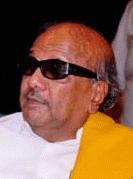Commentary / Mani Shankar Aiyar
The Jain Commission can at last focus on the 'sequence of events' which led to Rajiv's killing
 On May 21, 1991, Rajiv Gandhi was blown up at Sriperumbudur, Tamil
Nadu, by a human bomb detonated by the Sri Lankan Tamil terrorist
organisation, the Liberation Tigers of Tamil Eelam. A mere
110 days earlier, the DMK government in the state had been dismissed
by the Centre under Article 356 of the Constitution for the close
ties that allegedly subsisted between the outlawed LTTE and the
DMK-run state government.
On May 21, 1991, Rajiv Gandhi was blown up at Sriperumbudur, Tamil
Nadu, by a human bomb detonated by the Sri Lankan Tamil terrorist
organisation, the Liberation Tigers of Tamil Eelam. A mere
110 days earlier, the DMK government in the state had been dismissed
by the Centre under Article 356 of the Constitution for the close
ties that allegedly subsisted between the outlawed LTTE and the
DMK-run state government.
One of the major tasks before the Jain
Commission is to unearth the nexus, if any, between the LTTE and
the DMK and the relationship, if any, between that nexus and the
assassination of Rajiv Gandhi. After more than five years of finding
its inquiry stymied at virtually every turn, the Jain Commission
is at last reaching the point where it can start focusing in earnest
on the 'sequence of events' which led to the killing.
Justice Milap Chand Jain will be ascertaining whether two crucial
events in the year leading to the assassination had a bearing
on the assassination -- first, the massacre of Padmanabhan and 15
of his EPRLF associates by the LTTE in Madras (Chennai) in June
1990; and, second, the dismissal of the Karunanidhi government
on January, 31, 1991, by the Chandra Shekhar government when it
still had three years to run of the mandate it had secured from
the people of Tamil Nadu in the election of January 1989.
The home secretary to the Karunanidhi government has already deposed
before the commission. So have the prime minister and home minister
of the day, Chandra Shekhar and Subodh Kant Sahay. V P Singh
is, at the moment of writing, deposing at length over a period
of several days.
 Within the next few weeks, between the commencement
of the Puja/Navaratri celebrations and Deepavali, the Jain Commission
is expected to see a galaxy of the key personalities of that period
coming before the commission: Karunanidhi himself; Jayalalitha
who succeeded him as chief minister; and P Chidambaram, now in
alliance with Karunanidhi but in 1991 the most articulate exponent
of the DMK- LTTE nexus and subsequently (24.5.95. to 1.4.96)
minister in charge of the investigation.
Within the next few weeks, between the commencement
of the Puja/Navaratri celebrations and Deepavali, the Jain Commission
is expected to see a galaxy of the key personalities of that period
coming before the commission: Karunanidhi himself; Jayalalitha
who succeeded him as chief minister; and P Chidambaram, now in
alliance with Karunanidhi but in 1991 the most articulate exponent
of the DMK- LTTE nexus and subsequently (24.5.95. to 1.4.96)
minister in charge of the investigation.
To assist the reader in making sense of the stray bits and pieces
which the press will be carrying of these depositions I
offers this guide to what to look out for as the inquiry enters
its most crucial phase.
First, the nexus. From July 1983 to July 1987, there was a tremendous
wave of sympathy all over India, cutting across party lines, for
the plight of the Tamil citizens of Sri Lanka. The proximate cause
of the sympathy wave was the massacre in July 1983 of prisoners
of Tamil origin in a Colombo jail which signalled the intensification
of the brutal suppression of the movement promoted by a number
of Sri Lankan Tamil organisations for freedom for the Tamils through
regional autonomy or, preferably, a sovereign state of their own
('Eelam').
It was recognised that some of these Tamil organisations
were non-violent in character and attempting to achieve their
goals through a democratic political process while others were
dedicated to violence, insurrection and revolution. Both sets of
organisations turned to India for solace and succour; both in
turn were provided by the Government of India, in association with
the state government of Tamil Nadu, some of it in a clandestine
manner.
|





 On May 21, 1991, Rajiv Gandhi was blown up at Sriperumbudur, Tamil
Nadu, by a human bomb detonated by the Sri Lankan Tamil terrorist
organisation, the Liberation Tigers of Tamil Eelam. A mere
110 days earlier, the DMK government in the state had been dismissed
by the Centre under Article 356 of the Constitution for the close
ties that allegedly subsisted between the outlawed LTTE and the
DMK-run state government.
On May 21, 1991, Rajiv Gandhi was blown up at Sriperumbudur, Tamil
Nadu, by a human bomb detonated by the Sri Lankan Tamil terrorist
organisation, the Liberation Tigers of Tamil Eelam. A mere
110 days earlier, the DMK government in the state had been dismissed
by the Centre under Article 356 of the Constitution for the close
ties that allegedly subsisted between the outlawed LTTE and the
DMK-run state government.
 Within the next few weeks, between the commencement
of the Puja/Navaratri celebrations and Deepavali, the Jain Commission
is expected to see a galaxy of the key personalities of that period
coming before the commission: Karunanidhi himself; Jayalalitha
who succeeded him as chief minister; and P Chidambaram, now in
alliance with Karunanidhi but in 1991 the most articulate exponent
of the DMK- LTTE nexus and subsequently (24.5.95. to 1.4.96)
minister in charge of the investigation.
Within the next few weeks, between the commencement
of the Puja/Navaratri celebrations and Deepavali, the Jain Commission
is expected to see a galaxy of the key personalities of that period
coming before the commission: Karunanidhi himself; Jayalalitha
who succeeded him as chief minister; and P Chidambaram, now in
alliance with Karunanidhi but in 1991 the most articulate exponent
of the DMK- LTTE nexus and subsequently (24.5.95. to 1.4.96)
minister in charge of the investigation.